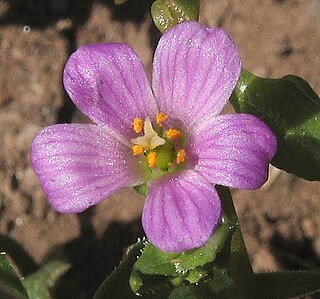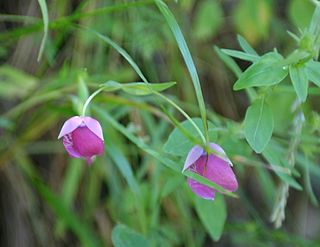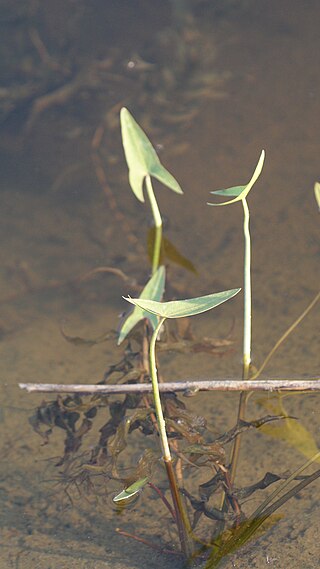
Eriogonum davidsonii is a species of wild buckwheat known by the common name Davidson's buckwheat. This plant is native to the southwestern United States and northern Baja California. It grows in sandy or gravelly soils, mixed grassland, saltbush, chaparral, sagebrush communities as well as oak and montane conifer woodland. It is a spindly annual herb growing up to 40 centimeters in height. Leaves are fuzzy, basal, and round with wavy or wrinkly margins fuzzy. They are two centimeters wide. The plant is variable in appearance, but is usually erect with thin, naked, neatly branching stems bearing clusters of tiny flowers at widely spaced nodes. Each flower is about 2 millimeters wide, bell-shaped, and can be white, pink or red. Flowering occurs May to September.

Sagittaria montevidensis is a species of flowering plant in the water-plantain family Alismataceae. Common names include giant arrowhead and California arrowhead.

Arctostaphylos mewukka is a species of manzanita known by the common name Indian manzanita.

Atriplex lentiformis is a species of saltbush.
Atriplex phyllostegia is a species of saltbush known by the common names arrowscale, leafcover saltweed, and Truckee orach. It is native to the western United States from California to Utah, where it grows in meadow bottoms and areas with saline soils such as dry or ephemeral lakes.
Bernardia myricifolia is a species of flowering plant in the spurge family known by the common name mouse's eye. It is also called mouse ear, or oreja de ratón in Spanish. It is native to Texas, New Mexico, and Mexico. It grows in shrub communities on rocky, limestone hills. This is a perennial shrub growing over three meters in maximum height. The small leaves are each up to three centimeters long, oval in shape, with scallop-shaped teeth along the edges. A dioecious species, male and female individuals produce different types of flowers. Staminate inflorescences are small clusters of male flowers, and pistillate inflorescences bear solitary female flowers. The fruit is a roughly rounded woolly capsule with three prominent chambers, each containing a seed.

Calandrinia breweri is a species of flowering plant in the family Montiaceae known by the common name Brewer's redmaids.

Calochortus amoenus is a species of flowering plant in the lily family which is commonly known as purple fairy-lantern.

Nitrophila mohavensis is a rare species of flowering plant in the family Amaranthaceae known by the common name Amargosa niterwort. It is endemic to Nye County in southwestern Nevada and Inyo County, in eastern California.

Sagittaria lancifolia, the bulltongue arrowhead, is a perennial, monocot plant in the family Alismataceae, genus Sagittaria, with herbaceous growth patterns. It is native to the southeastern United States. It is known from every coastal state from Delaware to Texas. The species is also considered native to Mexico, Central America, the West Indies and northern South America. It has become naturalized on the Island of Java in Indonesia.
Psilocarphus oregonus is a species of flowering plant in the family Asteraceae known by the common names Oregon woollyheads and Oregon woolly marbles. It is native to western North America from Washington and Idaho to Baja California, where it grows in seasonally wet habitat, such as vernal pools.

Sagittaria cuneata is a species of flowering plant in the water plantain family known by the common name arumleaf arrowhead or duck potato. Like some other Sagittaria species, it may be called wapato. It is native to much of North America, including most of Canada as well as the western and northeastern United States.

Sagittaria longiloba is a species of flowering plant in the water plantain family known by the common name longbarb arrowhead and Gregg arrowhead. It is native to the south-central and southwestern United States plus Mexico, Venezuela and Nicaragua. It is also reportedly naturalized in the western Himalayas of India and Bhutan. It grows in slow-moving, stagnant, and ephemeral water bodies such as ponds and small streams, and sometimes disturbed and cultivated habitat such as rice fields and irrigation ditches.

Smilax jamesii is a species of flowering plant in the greenbriar family known by the common name English Peak greenbriar. It is to northern California, where it is known from the Klamath Mountains and the southernmost peaks of the Cascade Range. It has also been reported from nearby locations in southwestern Oregon. It grows in moist areas such as lakesides and streambanks in mountain coniferous forest habitat. It was discovered to be a new species when herbarium specimens thought to be Smilax californica were reexamined.
Tetracoccus ilicifolius is a rare species of flowering shrub in the family Picrodendraceae known by the common names hollybush and holly-leaved tetracoccus.

Sagittaria platyphylla, the delta arrowhead, broad-leaf arrowhead or delta duck-potato, is a plant species native to the eastern United States. The core of its range extends from central Texas to the Florida Panhandle north to southern Illinois.

Sagittaria rigida, the sessilefruit arrowhead or Canadian arrowhead, is an aquatic plant species native to Canada and to the United States and also naturalized in Great Britain. It grows in shallow waters along the edges of ponds and streams. What is really interesting is that it has narrow oval leaves rather than the iconic arrowhead shaped leaves of species like the Sagittaria latifolia. it has sessile female flowers, which is where it gets its name from. Its flowers are very similar to other plants in the Sagittaria family, with three white petals. It grows "potato" like tubers which can be eaten. Gathering any tubers from the Sagittaria family can be dangerous if gathered from polluted water.

Sagittaria teres, the quill-leaved arrowhead or slender arrowhead, is an aquatic plant species in the genus Sagittaria native to the northeastern United States: Rhode Island, Massachusetts, New Hampshire, New York and New Jersey.
Sagittaria brevirostra, common name Midwestern arrowhead or shortbeak arrowhead, is an aquatic plant species native to North America. It is common in wet places in an area stretching from Michigan and Ohio south to Alabama and west to North Dakota, Colorado and northern New Mexico, plus isolated populations in Maryland, New Brunswick, Virginia, Saskatchewan and California.

Sagittaria graminea, the grassy arrowhead or grass-leaved arrowhead, is an aquatic plant species native to eastern North America.
















